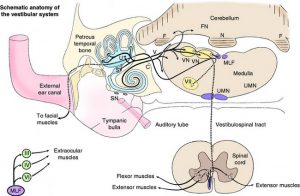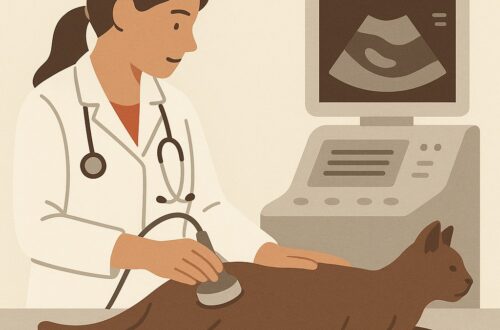As a child (and honestly even now as an adult) I abhorred amusement park rides that moved in circular patterns because they made me inevitably vomit due to vertigo. Roller coasters? Great! The Gravitron? Over my dead body! I don’t need to put myself into a human centrifuge. I hate feeling dizzy! The major part of the body that helps control dizziness is called the vestibular system. Our dogs and cats may contract various diseases of this integral system, causing vertigo and intense nausea. Too few pet parents are aware of these ailments. So, this week I’ve composed some key information to help you understand vestibular disease in our furry companions. Happy reading!
Vestibular Disease – What is it?
The vestibular system is a large and complicated one. It has several unique components that connect and communicate with other parts of the nervous system and body. Through these complex interactions, the vestibular system allows pets to maintain normal positioning of their eyes, body, and limbs with respect to their heads. Anything that causes damage – temporary or permanent – to either part of the vestibular system may cause balance issues, as well as abnormal head and eye movements.

Given the size of the vestibular system, veterinarians anatomically divide it into two parts – the peripheral vestibular system and the central vestibular system. Different diseases affect each part of the vestibular system:
- Peripheral vestibular diseases
- Middle & inner ear inflammation (called otitis media and otitis interna, respectively)
- Trauma
- Idiopathic vestibular disease
- Tumors of cranial nerve #8 (called the vestibulocochlear nerve)
- Toxins that directly damage cranial nerve #8
- Central vestibular diseases
- Brain cancer
- Immune-mediated conditions (i.e.: granulomatous meningoencephalitis or GME)
- Infections (i.e.: canine distemper, fungal infections like aspergillosis and cryptococcosis, toxins, toxoplasmosis, feline infectious peritonitis)
- Hypothyroidism
- Vascular leak syndrome
Vestibular Diseases – What does they look like?
The clinical signs seen in dogs and cats with vestibular diseases is quite variable. Often the only sign may be a slight head tilt. More severely affected dogs may be so unsteady while walking that they collapse and appear to have seizures. Common clinical signs include:
- Unsteadiness while walking (called ataxia)
- Abnormal eye movements (called nystagmus and strabismus)
- Inability to right itself
- Nausea / vomiting
- Reduced (or loss of) appetite
- Falling and rolling to one side
Vestibular Diseases – How are they diagnosed?
A veterinarian will obtain a thorough medical history, paying particular attention to a pet’s travel history and exposure to potential toxins. The doctor will also perform a complete physical examination, including an extensive evaluation of a pet’s nervous system. Given the complexity of the nervous system, many primary care doctors will recommend partnering with a board-certified veterinary neurologist, a veterinary with specialized training in neurologic disorders including vestibular diseases. Pet parents should be prepared for a veterinarian to recommend a series of tests, including:
- Blood and urine assays to evaluate the health of major organ systems
- Blood pressure measurement
- Blood tests to check a patient’s ability to clot blood properly
- Testing on blood, urine, and/or cerebrospinal fluid to look for infectious organisms and inflammation – see video below from our friends at VetGirl.
- Advanced imaging of the brain in the form of computed tomography (CT scan) and/or magnetic resonance imaging (MRI)
Given the potential need for potential extensive testing, pets will likely find it helpful to collaborate with a board-certified veterinary neurologist to develop a logical and cost-effective diagnostic plan.
Vestibular Diseases – How are they treated?
Definitive treatment of vestibular diseases depends on the underlying cause. For this reason, as mentioned earlier, a properly thorough diagnostic investigation is of paramount importance. Patients with middle and inner ear inflammation and infection often require both topical and systemic therapies for approximately one month; some require a minimally invasive procedure called a myringotomy and aural lavage. Patients with confirmed hypothyroidism need to be supplemented with thyroid hormone. Given the dizziness most patients experience, they are often nauseated and thus benefit from anti-nausea medication(s). Patients with protozoal, fungal, bacterial, and/or parasitic infections require specific drugs to fight their diseases. Those with tumors – benign or malignant – may need surgery and/or radiation therapy. Pet parents will likely find it helpful to partner with a board-certified veterinary neurologist ensure their pet is receiving the most appropriate therapies.
The take-away message about vestibular diseases in dogs & cats…
Vestibular diseases cause dogs and cats to feel dizzy, negatively affecting their quality of life. The vestibular system is a complex one and there are many ailments that may affect it. A thorough diagnostic investigation is warranted for any pet with clinical signs referable to the vestibular system, and treatment is based on a definitive diagnosis.
To find a board-certified veterinary neurologist, please visit the American College of Veterinary Medicine.
Wishing you wet-nosed kisses,
CriticalCareDVM





